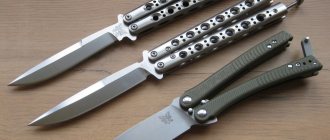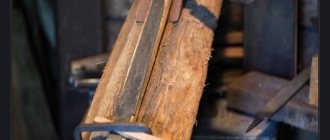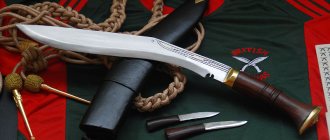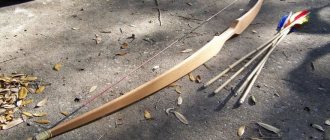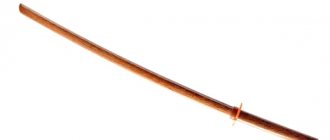The Malay archipelago is the birthplace of great warriors and skilled gunsmiths. One of the greatest creations of this region is the karambit knife. Externally, it is a short sickle-shaped blade, sharpened only on the concave side. The handle, as a rule, ends with a ring for the finger, index, or little finger, depending on which grip the fighter prefers to take it with. Using the ring, you can twist the knife, confusing the enemy and giving the blows even more surprise and force. It also gives the grip high strength. It is virtually impossible to knock a karambit with a ring out of your hand.
The Malays, the inventors of the knife, also came up with a deadly technique for using it. It is the basis of the art of fighting “silat”. Strikes similar to tiger strikes form the basis of the technique. Masters of using karambit are capable of inflicting fatal wounds in a few moments, tearing the blood vessels, tendons and muscles of the enemy.
Everything about this weapon is unique, the shape of the knife and the manner of fighting with it, and even the history of its appearance is ambiguous and full of secrets.
Types and standards of characteristics of karambits
The standard of the classic version of karambit can be called a knife with a length not exceeding 20 cm, despite the fact that the blade in it occupies an average of 3-8 cm. The blade has a strong bend and is sharpened only on its inner side. The handle is a metal continuation of the blade, with two plates (wooden, plastic or bone). The knife does not have a guard.
However, all these characteristics are not strictly established. Sharpening can also be done on the outside of the blade. A finger ring is a very common element, but also not necessary. The length of the blade, as well as its bend, also vary. There are also no specific characteristics of the metal for making karambit.
The only significant criterion by which karambits can be divided into types is the ability or impossibility of folding the knife blade.
- Folding knives are traditional weapons. This is exactly how karambit was originally intended. Its main problem is that it is bulky and difficult to unsheath due to the shape of the blade.
- The folding karambit is designed to reduce the space occupied by the knife, and it actually becomes pocket-sized, safe for carrying. He no longer needs the scabbard.
Modern manufacturers of knife models also create products that use only individual elements of this knife in their design. It is no longer possible to call them karambits, although their external characteristics are sometimes quite similar.
From the history
This unique weapon has a rich history. The earliest mentions of karambit date back to the 12th century. But it is impossible to know the true history; it is shrouded in legends.
According to one of them, in parts of Indonesia, the local people had a cult of the tiger. People considered him a formidable jungle dweller. They thought that when they died, the souls of their kings transmigrated into the tiger. And the local population began to make combat knives, copying the appearance of a tiger claw. According to other versions, the blade originated either from the demon Bima, whose main weapon was claws, or from the king of the monkeys, who had a magical claw in his palm.
Most likely, the actual prototype of the blade was an ordinary sickle, and the hole was a necessity so that the object would not accidentally fall out of the hand. In these areas, the most common work was in the rice fields - in the water.
In ancient times, it was common on the Indonesian islands to smear the blade with strong poison. As a result of a small, lacerated wound, the enemy died instantly.
Along with heavy types of karambits, there were small ones - for domestic needs and self-defense.
The blade was made like this:
- carbon steel;
- the handle was made of wood or from the horn of an animal;
- the scabbard was made of wood, decorated, but did not have pendants; the blade was intended to be worn in the belt.
Karambit became the prototype of the Bulang blades, which were tied to the legs of roosters in cockfights.
Is it a cold weapon?
Law-abiding readers are probably interested in knowing whether karambit is considered a bladed weapon in Russia, and whether it can be freely carried and used as a weapon for self-defense. The answers to both questions are negative.
Despite the difference in the bend and length of the blade, all knives that can be called karambits, without exception, have characteristics that, according to the laws of the Russian Federation, are defined as cutting and skinning knives. Confirmation of this is found in clause 5.1.2.3, GOST R 51644-2000, which determines the technical standards for bending the blades of such knives.
Similar requirements are established not only in Russia. These also include Ukraine, as well as Belarus and other countries. The laws of these states allow the free sale and wearing of karambits by all citizens. No special permits are needed, and there are no problems purchasing karambit. It is not a melee weapon.
Shuko
Karambit knife: history of appearance and development, design and performance characteristics, types of classic copies, main effectiveness, advantages and disadvantages
Shuko is another type of fighting claw ("tekagi" or "hand hook") used by shinobi. Unlike other types, here the sharp spikes are located on the inside of the palm, while the hand is protected from them by tightly rolled steel strips and leather straps.
The main purpose of shuko, however, is not combat - they were primarily used to cling more strongly to the surface while climbing trees and walls. Even after years of training, a person cannot hang on branches and trunks for too long, and hooks went some way to solving this problem during ambushes and reconnaissance missions.
The combat use of shuko today is taught in the Togakure-ryu school of hand-to-hand combat. Basically, they are used in the same way as other claws - for sudden attacks, when the fighter tries to slash the face and neck of the enemy. Due to the shape of the hooks, wounds inflicted by shuko do not heal for a long time and leave ugly scars for life.
How to make karambit with your own hands
You can make fairly high-quality karambit at home. To do this, you will need a workpiece made of high-quality metal (for example, a circular saw blade), nitrocellulose varnish, tin wire, a power source, and... a drawing of a karambit (you can find it on the Internet or draw it yourself).
The surface of the workpiece must first be sanded and degreased, then covered with a layer of varnish. Three layers is enough. The knife drawing is placed on top and outlined. Tin wire is laid along the contour. The wire is connected to the negative terminal of the current source, and the workpiece to the positive one. The oxidation reaction begins. Upon completion, the contour of the knife will easily move away from the workpiece. All that remains is to refine it with a grinding tool and sharpen it.
You can also make karambit from sheet metal.
Design Features
Karambit is a blade designed specifically for the Asian martial art of silat. The shape is very specific, related to the purpose of the item. No wonder its second name is the killer’s dagger. The photo shows a sample of karambit.
The knife has a curved blade and is held with a reverse grip, that is, sharpened towards you. To prevent the blade from slipping out of wet palms, there is a hole in its handle, usually for the middle finger. The blade is sharpened along the inner fold. The handle is usually made of hard wood, the blade is secured with a rivet.
The dimensions of the CS GO blade are small - from 3 to 10 cm, but there are modifications up to 30 cm in length. In addition, it can have 2 blades, the handle can be made without a hole, and so on.
Surprise is the main trump card of karambit in close combat. The tiny blade, 5 cm long, is completely invisible until it is used in battle. The main goal in this case is to defeat the arms and legs, that is, to incapacitate the opponent. However, using the weapon requires experience.
The blade, as can be seen from its shape, is designed to make ripping cuts, not piercing ones, which, by the way, makes it a good weapon for immobilizing an enemy, but bad for killing. When wounded, the tip of the knife rips the skin along the surface, immediately disabling the entire muscle. In order for the weapon to be truly lethal, deadly poisons were previously applied to its blade.
Application
Naturally, the original purpose of karambits was to use them as the main weapon in battle. The most effective techniques were developed in the homeland of weapons in the Malay Islands. But it’s not only there that karambits are used. American intelligence officials also have such knives in their arsenal. True, only as additional ones. Well, in the homeland, a knife is not just a bladed weapon, but a source of national pride. And it is used very widely by all segments of the population.
Historically correct knife grip, reverse. The blows he delivers are fast, sharp and must be accurate. Survival depends on it. Many techniques for using karambit are tied to getting as close as possible to your opponents. The blows delivered by the karambit are cutting and it is absolutely impossible to stab the enemy with it, with such a bend of the blade. This is not a bayonet.
The historically established methods of using karambit as a bladed weapon specifically for strikes in close combat are not accidental. These are not throwing knives. However, it is still possible to throw such a blade, but the effectiveness of hits will be much less due to the strong bending of the blade.
The knife shows perfectly when it is used in everyday life. Experts say that we still need to look for a more convenient blade for cutting hunted animals, fish, skinning and peeling vegetables. And this is not surprising if we take into account one of the versions about the origin of the first karambits, from the sickles of ordinary farmers
It is stated above that karambit does not recognize the laws of cold weapons. This made it popular as a weapon for self-defense. There are schools for teaching how to use it for these purposes, because without training it is impossible to use it effectively. But even for a skilled person, such a knife will not help much in case of danger. If there are many opponents and they are wearing jackets (especially in winter), the knife will not be able to harm them. The other extreme would be too high a probability of death or damage dangerous to health and life, which does not fit very well with the term “self-defense,” at least according to the laws in force in the Russian Federation. That is, in any case, using karambit for self-defense is quite risky.
If you still want to use a karambit knife for self-defense. Be sure to enroll in appropriate self-defense courses.
Distribution across the globe
Nowadays it’s difficult to find a place where they don’t know about the karambit knife. It is widespread in its homeland and in many parts of the world. Its models are being improved, new elements are being added, although this is no longer the classic form of karambit, but this does not lose demand.
The first karambits came to the American continent along with emigrating citizens from Southeast Asia. At that time, few people paid attention to this knife design. The unusual device was not noticed for a long time. But in the 80s of the last century, with the revival of martial arts, interest was shown in him.
Masters of Asian martial arts: Indonesian - Pencak Silat and Filipino - Pekiti-tirsia Kali, showed their skill and technique of using karambit in battle.
After this, many in the West became interested in this knife, which was the beginning of rush demand and the development of the knife industry.
Manufacturers created and combined classic elements of karambit based on other well-known knife models, not forgetting to produce real Malay devices for martial arts practitioners. To use the unique capabilities of karambit, long training is required under the guidance of experienced instructors.
Today, in the catalogs of all well-known knife manufacturers you can find different types of karambit.
Advantages and disadvantages
A clear advantage of karambit is its versatility when used both on the farm and in combat use. This includes a comfortable grip and a special blade shape. The external appearance of the decorated models equates it to a work of art.
It also has disadvantages. Firstly, it is inconvenient to carry (this does not apply to folding models). The curved blade, in addition to its advantages, also prevents the use of karambit as a piercing weapon, which is sometimes useful for domestic use. And the main disadvantage is that to use a knife effectively, you need professional training.
Operating technique
One of the most important factors is anatomical conformity. Otherwise, the owner will simply find it inconvenient to use it. The knife can be used in combination with or without other weapons. Even if there is only one knife, you can actively use the second hand to strike, block and grab.
Since karambit is used at close range, it is important to be able to move correctly and actively. At the moment, the knife can be taken in a reverse and forward grip.
- Reverse grip
This type of grip is a classic option. In this case, the handle is placed in the palm, the index finger is threaded through the ring, and the hand is clenched into a fist. Thus, you can strike not only with a knife, but also with your fist.
- Straight grip
This option is exactly the opposite of the first. In this case, the blade comes out of the thumb, and the little finger is threaded into the ring.
Cat Claw
This baby karambit is part of a series of self-defense knives called “Neck babies”. The name of the series is associated with the main way of wearing these knives - on a chain, on the neck.
“Cat's Claw”, like the entire series, refers to knives for concealed carry. The knife has a sickle-shaped blade, there is no handle as such - a metal ring at the base of the blade is used to hold the knife in the hand.
Characteristics of the "Cat's Claw" knife:
Total length – 10 cm (4″)
Blade length – 6.3 cm (2 1/2″)
Weight - 2 oz
Price: $95
The main grip of the knife is straight. In this case, the middle finger is threaded into the ring, and the base of the blade is clamped between the index finger and thumb. The knife can be held covertly in the palm, and it is enough to make half a turn with the knife around the middle finger and the knife is ready to attack.
This grip of the knife ensures a very secure hold of the knife in your hand. Cutting blows with such a grip cut through the clothing and upper tissues of the enemy, providing a strong painful effect. However, this is only true in the warm season for light outerwear. In winter, when clothing becomes thicker, a knife of this size becomes ineffective.
The Cat's Claw is also available in plastic, making it invisible to metal detectors.


